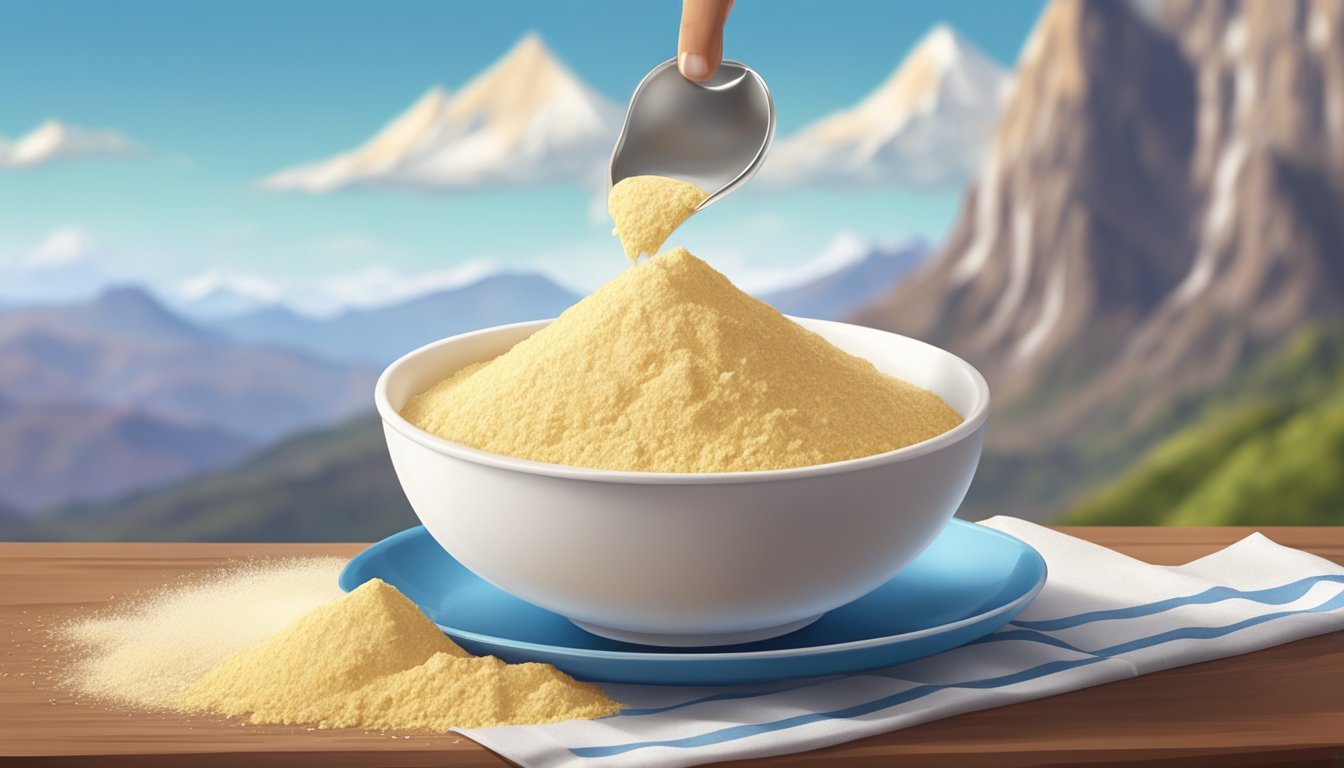How to Convert Measurements for High-Altitude Baking
Precise Adjustments for Perfect Results
Baking at high altitudes presents a unique set of challenges due to the lower air pressure compared to sea level. As elevation increases, this decrease in pressure can affect the behavior of certain ingredients and the overall chemistry of baking. Recipes developed near sea level often require adjustments to work properly at higher elevations, where the boiling point of water is lower, and leavening gases in doughs and batters expand more.
To ensure success when baking at heights above 3,000 feet, bakers may need to tweak ingredient proportions, oven temperature, and cooking time. The adjustments can vary depending on the type of baked good and the altitude. Generally, bakers may find the need to increase liquid, reduce sugar, decrease leavening agents, and potentially raise the baking temperature to compensate for faster evaporation and expansion rates.
Successful high-altitude baking is about precision and adaptation. Incremental changes to recipe measurements can help maintain the delicate balance necessary for achieving desirable textures and flavors. Bakers at altitude might experiment with these alterations—one could add an extra egg for additional moisture, decrease sweeteners to prevent overspreading, or modify baking powder amounts to control the rise of cakes and breads for optimal results.
Understanding High Altitude Baking
When baking at high altitudes, bakers must adjust their recipes to account for decreased air pressure and its consequences on evaporation, leavening, and other cooking processes.
Effects of Altitude on Baking
At high altitudes, the air pressure is lower, which affects baking in several ways. One of the primary effects is on leavening. Gases in leavening agents, like baking powder and yeast, expand more quickly due to lower air pressure. This can cause baked goods to rise too rapidly and then collapse. Evaporation also occurs more swiftly, which can lead to drier baked products.
To counteract these effects, bakers need to consider several adjustments:
Baking Time: Typically, it's reduced by 5-8 minutes for every 30 minutes of baking time.
Oven Temperature: One might need to increase the temperature to compensate for faster water evaporation.
Liquid: The amount of liquid may need increasing to make up for quicker evaporation rates and provide enough steam for proper rising.
Sugar: Reducing the amount helps to prevent the over-browning and collapsing of baked goods.
High-Altitude Science
The science behind high-altitude adjustments centers around the lower boiling point of water and changes in chemical reactions. Water boils at a lower temperature at high altitudes due to reduced air pressure, affecting cooking times and texture. Balancing oven temperature and baking time is essential to ensure that the inside of baked goods cooks properly before the outside becomes overdone.
Leavening adjustments are crucial:
Baking Powder: Decrease by up to half a teaspoon to prevent over-rising.
Sugar: To moderate sweetness and structural issues, a reduction of 1-2 tablespoons per cup may be necessary.
Liquid: More may be required to compensate for the faster loss due to evaporation.
In terms of flavor, more time is sometimes needed to develop the right taste, especially in bread, which might require additional rising periods.
Adjusting Leavening Agents
One critical aspect of high-altitude baking is altering the quantities of leavening agents to prevent overexpansion and the resultant collapse of baked goods. These adjustments are essential to achieve the desired texture and rise in your baked creations.
Baking Powder and Baking Soda
At higher altitudes, the decrease in atmospheric pressure means that gases produced by leavening agents expand more than they would at sea level. Therefore, baking powder and baking soda, common leavening agents, need to be reduced to prevent baked goods from rising too quickly and becoming dry or overly porous.
For every teaspoon of baking powder or soda used at sea level, consider decreasing by:
1/8 teaspoon at 3,000 feet
1/8 to 1/4 teaspoon at 5,000 feet
1/4 teaspoon or slightly more above 7,000 feet
This reduction helps maintain the proper chemical reaction in recipes and ensures a stable structure in the final product.
Yeast in Breads
Yeast breads require a different approach. Since yeasts are living organisms, their activity is increased at higher elevations due to quicker gas production. To counteract this effect and avoid overproofed bread, bakers should reduce the amount of yeast used or shorten the rising times.
The adjustments for yeast in high-altitude baking might include:
Reducing yeast by about 25% for elevations over 3,000 feet.
Alternatively, one could keep the yeast quantity the same but decrease the rising time, closely monitoring the dough's progress.
Ensuring that yeast breads retain their texture and do not overinflate requires careful observation and possibly a few attempts to perfect. The baker's goal is to allow the dough to rise just enough to impart the right flavor and structure without reaching overexpansion.
Regulating Sugars and Fats
When baking at high altitudes, it's important to adjust sugar and fat quantities to maintain the desired texture and structure of baked goods, as the reduced air pressure can affect how these ingredients behave.
Sugar Alterations
For recipes that include sugar, a reduction in the overall concentration is often necessary. At altitudes above 7,000 feet, one could typically decrease the sugar by 1 to 3 tablespoons per cup used in the recipe. This helps prevent the excess caramelization and overly moist structure that might occur due to the prolonged boiling point of water at higher elevations.
Altitude of 7,000+ feet: Decrease sugar by 1 to 3 tablespoons per cup.
Managing Fat Content
Adjusting the amount of fats, including butter, shortening, or oil, is another crucial step in high-altitude baking. Generally, decreasing fats slightly can help strengthen the structure, which may be weakened by rapid gas expansion at high altitudes. A typical rule is to reduce the fat by 1 to 2 tablespoons per cup of fat included in the original recipe.
For oils and shortening: Decrease by 1 to 2 tablespoons per cup.
In addition, one might need to incorporate an extra liquid to compensate for the drier climate and increased rate of evaporation at higher elevations, although this pertains more to the overall moisture content rather than fats specifically.
Liquids and Flour Adjustments
When baking at high altitudes, adjustments to liquids and flour are crucial due to lower air pressure and faster evaporation rates. This section explains how to modify these components to maintain the desired texture and structure of baked goods.
Increasing Liquids
At higher elevations, bakers should increase the amount of liquid in their recipes. The drier air leads to faster evaporation during baking, which can result in drier, tougher products. To counteract this, they must add extra liquid:
At 3,000 feet, increase liquid by 1 to 2 tablespoons.
Add an additional 1 1/2 teaspoons of liquid for each 1,000 feet beyond that.
Using an extra egg is a way to introduce more liquid, plus it can enhance structure due to the egg's protein content.
Flour and Structure
Flour adjustments focus on strengthening the structure of baked goods, which can weaken due to the expansion of gases at high altitude:
Incorporate 1 tablespoon of extra flour at 3,000 feet elevation.
If baking at 5,000 feet or above, slightly increase the amount based on the recipe's requirements.
High-protein flour can bolster structure since protein strengthens gluten development.
Overall, the precise adjustments can depend on the specific recipe and altitude, but these guidelines provide a solid starting point for adapting liquids and flour for high-altitude baking.
Egg Modifications
When baking at high altitudes, the role of eggs becomes crucial for maintaining structure and hydration. Two key aspects to focus on are the roles eggs play in baking and the specific protein adjustments that may be necessary.
Egg Roles
Eggs serve multiple purposes in baking: they provide structure, act as a leavening agent, contribute to richness, and add moisture. The yolks, rich in fats, emulsify the batter which contributes to a smoother texture. Egg whites, on the other hand, when whipped, create air pockets that give cakes and other baked goods their lightness. In high-altitude baking, the decreased atmospheric pressure can cause the gas cells in the batter to expand too rapidly and escape, leading to a deflated structure.
Protein Adjustments
Protein in eggs contributes significantly to the structure of baked goods. At higher altitudes, bakers often need to increase the protein content to strengthen the batter or dough. This is typically achieved by adding an additional egg to the recipe, which can be particularly beneficial for rich, dense cakes. Adjusting protein content by adding eggs helps to:
Enhance hydration, as additional egg whites can bind more water, compensating for quicker evaporation at high altitudes.
Improve structure since the extra protein strengthens the cell walls, leading to a more stable and less likely to collapse crumb.
It is important to note that while adding eggs can help, one should refrain from overdoing it, as excessive protein can lead to a rubbery texture.
Adapting Cooking Temperatures and Times
When baking at high altitudes, adjustments to oven temperatures and baking times are critical to ensure successful outcomes.
Oven Temperature Considerations
Increasing the oven temperature is necessary to properly set batters and doughs before gases formed by leaveners have a chance to escape. Typically:
At 3,000 feet: Increase by 1 to 2 tablespoons of liquid and consider raising the oven temperature by 15-25°F.
At 5,500 feet: For recipes originally set at 350°F, one might increase the temperature to 365°F.
Above 7,000 feet: An increase in oven temperature by 25 degrees F is often recommended.
Modifications to Baking Durations
As the oven temperature rises, baking times usually decrease to prevent over-baking. Here's a general guide:
Reduce time: 5-8 minutes less per 30 minutes of the original recipe's baking time.
At 5,500 feet: Decrease the original baking time of about 75 minutes to approximately 70 minutes.
Above 7,000 feet: Consider reducing the baking time even further but keep a close eye on the doneness.
Types of High-Altitude Baked Goods
When baking at high altitudes, different categories of baked goods require specific adjustments. This section will review the conversion for cakes and quick breads, cookies and crackers, and pies and pastries.
Cakes and Quick Breads
Cakes and quick breads, such as muffins and banana bread, can overexpand and dry out due to quicker leavening and evaporation at higher elevations. For cakes, bakers often increase the oven temperature by 15-25°F to set the structure quickly, and decrease baking time by about 5-8 minutes for every 30 minutes of baking time. Sponge cakes demand careful attention, as they rely on trapped air for structure.
For quick breads, adjustments might include:
Decreasing the amount of baking powder; typically by about ½ teaspoon for 5,500 feet elevation.
Reducing sugar and increasing liquid slightly to maintain moisture.
Cookies and Crackers
Cookies and crackers may spread too much or too little when the air pressure is lower. To counteract this, bakers might:
Adjust the oven temperature: baking at a slightly higher temperature can help set the cookies before they spread too far.
Alter the amount of flour: adding a bit more flour can strengthen the dough and reduce excessive spreading.
Pies and Pastries
For pie crusts and pastries, the reduced air pressure can affect the texture. Flakiness can be achieved with a few modifications, including:
Increasing liquid: This compensates for faster evaporation at high altitudes.
Shortening baking time: to prevent drying out, as liquids evaporate more rapidly, potentially causing the dough to harden quicker than at sea level.
Each type of baked good requires careful tweaking of ingredients and baking parameters to ensure successful high-altitude baking.
High-Altitude Baking Guidelines
In high-altitude baking, accurate adjustments to a recipe are crucial to compensate for the lower air pressure. These changes ensure that baked goods rise properly and maintain their texture and flavor.
General Tips
At high altitudes, air pressure is lower, which affects baking in a few ways. Baked goods can rise more quickly and dry out faster. Cookbooks and reliable sources such as Colorado State University provide a wealth of information tailored specifically to high-altitude baking.
Leavening Agents: Bakers should reduce the amount of leavening agent to prevent overexpansion.
Increased Liquid: Recipes require more liquid to compensate for quicker evaporation.
Temperature and Time: Often, baking at a slightly higher temperature for a shorter period yields better results.
Recipe Adjustments
Bakers must adjust recipes methodically to ensure success in high-altitude baking:
Flour: Increase the amount slightly to provide more structure.
Sugar: Reduce the amount to prevent oversweetening and sinking.
Liquid: Add more to counteract the dry environment.
Leavening: Decrease leavening agents to control the rise of the bake.
Altitude (feet) Flour (add per cup) Sugar (reduce per cup) Liquid (add per cup) Baking Powder (reduce per tsp) 3,000 1-2 tbsp 1 tbsp 1-2 tbsp 1/8 tsp 5,000 2 tbsp 2 tbsp 2-3 tbsp 1/8 tsp 7,000+ 3 tbsp 3-4 tbsp 3-4 tbsp 1/4 tsp
These adjustments should serve as a starting point and may need to be fine-tuned based on individual recipes and results.
Common Challenges and Solutions
When baking at high altitudes, bakers often encounter issues with collapsing structures and increased dryness due to lower air pressure and faster evaporation. The right adjustments can ensure favorable results even in these challenging conditions.
Avoiding Collapsing and Dryness
Collapsing: To prevent baked goods from collapsing, which is common in high-altitude baking, bakers should adjust their leavening agents and baking temperature.
Leavening Adjustments: Decrease the amount of baking powder or baking soda, typically by about 15-25% per teaspoon the recipe calls for at sea level.
Temperature Adjustments: Raise the oven temperature slightly, by approximately 15-25°F, which helps set the structure of baked goods more quickly.
Dryness: Combat the quicker evaporation of moisture at high altitudes with the following tactics:
Increase Moist Ingredients: Add more liquid to recipes—about 1 to 2 tablespoons at 3,000 feet elevation and an additional 1 1/2 teaspoons for each extra 1,000 feet above that level.
Adjust Sugar: Too much sugar can exacerbate dryness; reduce the quantity by about 1-2 tablespoons per cup to help retain moisture.
Texture and Flavor Preservation
Dry Ingredients: At high altitudes, the balance of dry ingredients to wet ones is critical.
Flour: Add slightly more flour, potentially 1-2 tablespoons per cup, to avoid overly moist and dense outcomes.
Baking Time: Shorten the overall baking time, since baked goods can bake faster at high altitudes. A general rule is to decrease by 5-8 minutes per 30 minutes of baking time suggested at sea level.
Flavor: Elevation can dull flavor, so:
Spices and Extracts: Increase these slightly to maintain the desired taste profile.
Brownies: For rich flavors like in brownies, ensuring the proper balance of fats to dry ingredients will help preserve that deep, chocolatey experience. Adjusting sugar quantities not only influences moisture but can also intensify the desired flavor.
Implementing these adjustments with precision can make high-altitude baking a rewarding experience.
Additional Considerations for Specialty Baking
When adapting recipes for high-altitude baking, each specialty item, from yeast breads to fried dough treats, requires particular attention to compensate for the lower air pressure and altered boiling point of water.
Yeast Breads and Sourdough
For yeast breads, the faster rise due to lower air pressure at high altitudes means that dough may become over-proofed if left for the same time as at sea level. Bakers should decrease the amount of yeast and monitor dough rise more closely, aiming for volume increase rather than strict adherence to time. The fermentation rate increases at higher elevations, potentially altering the flavor of sourdough breads. To ensure a desirable taste and texture, bakers may need to:
Adjust the rise time
Decrease proofing time
Increase the flour slightly to strengthen the dough
Fried Dough and Special Treats
Frying dough at high-altitude requires a careful eye on temperatures and timings. Foods may absorb oil differently since the boiling point of water is lower. This can affect moisture content and cooking speed. For items like doughnuts or funnel cakes:
Maintain oil temperature a little higher than usual to account for rapid heat loss.
Cook for a shorter duration to avoid excessive oil absorption.
Implementing these adjustments will help maintain the expected flavor and texture, even when the baked goods and treats are made far above sea level.










